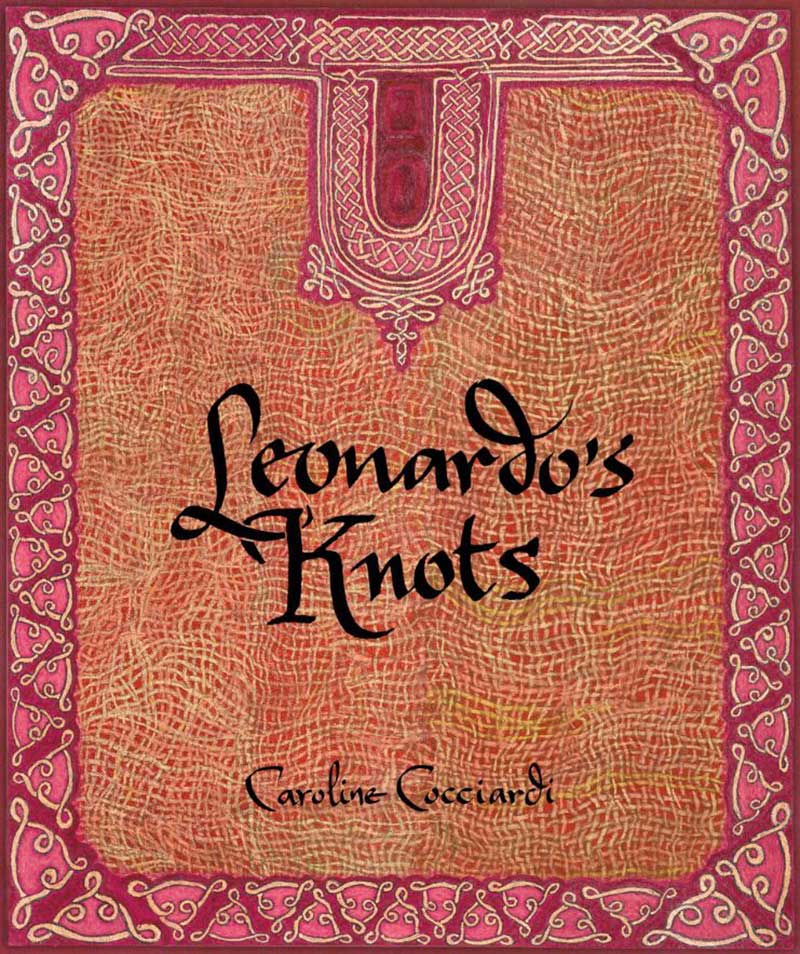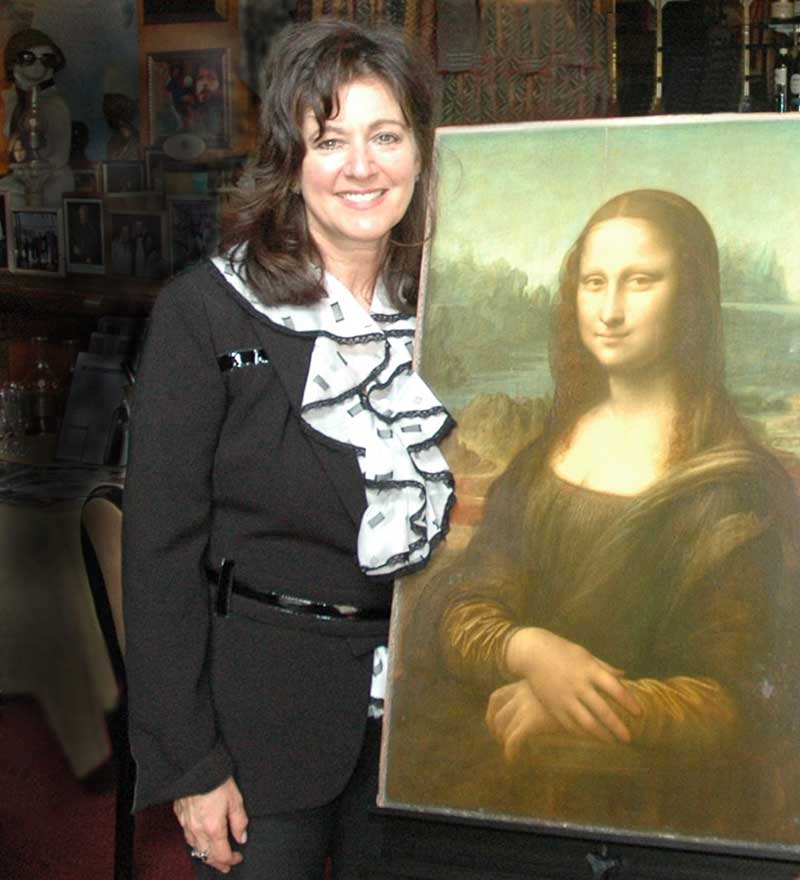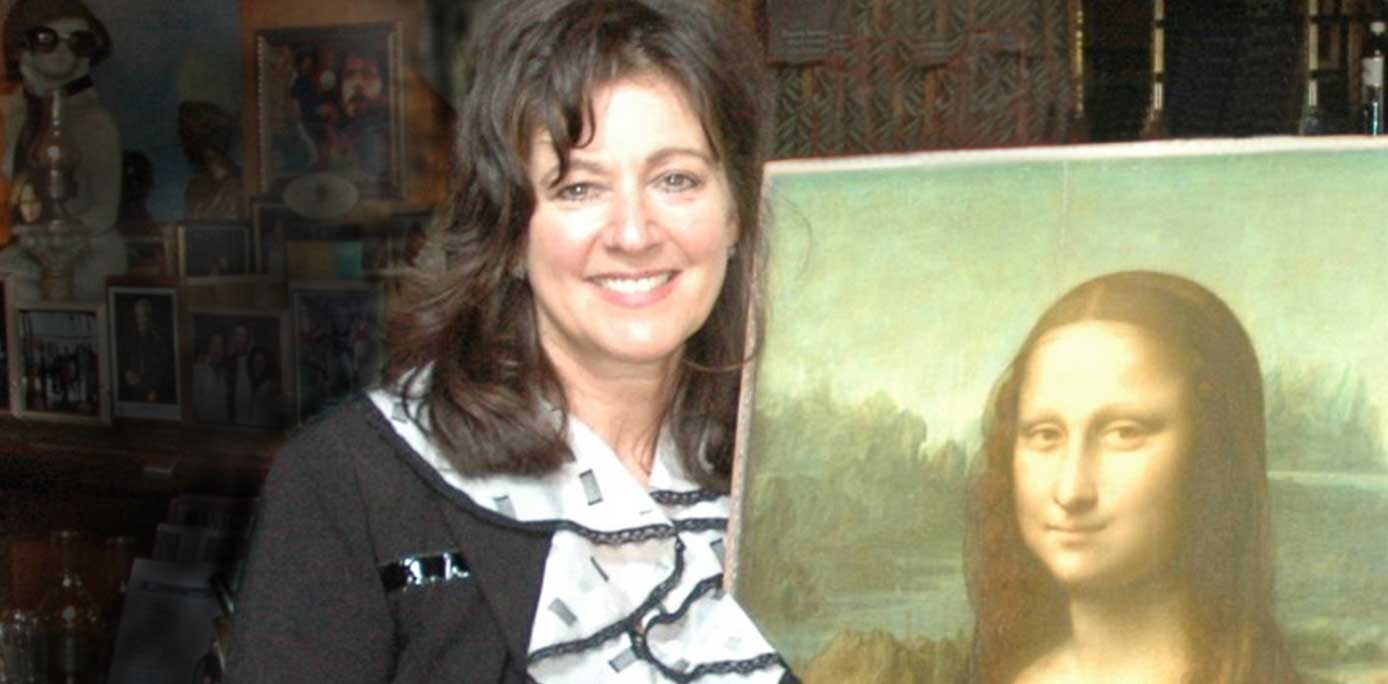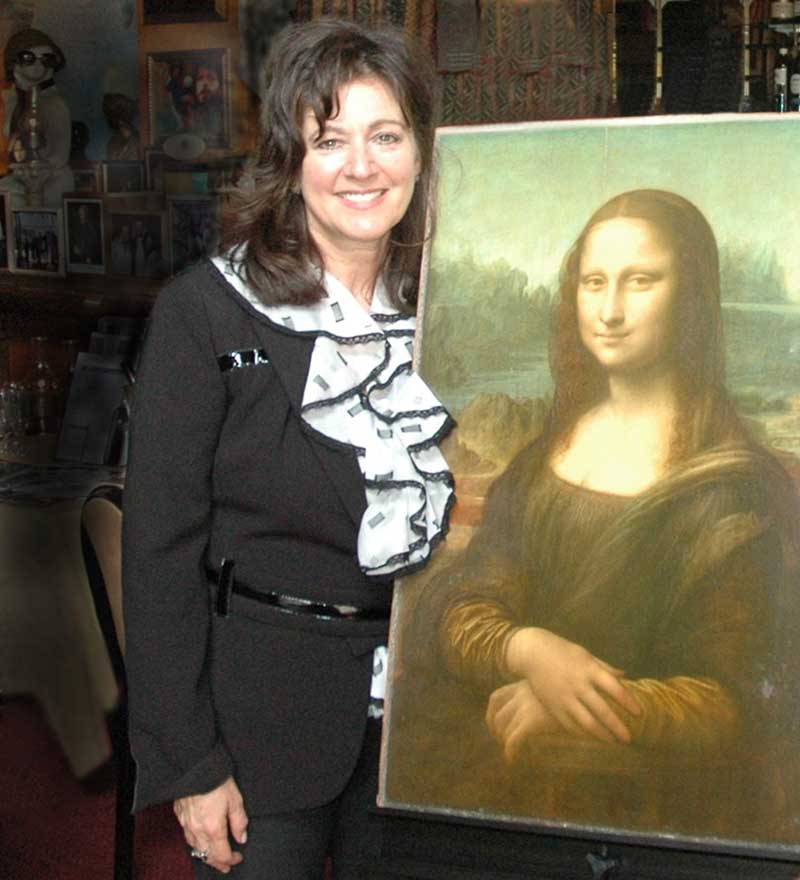In honor of the 500th anniversary of Leonardo da Vinci’s death (1452-1519), the San Francisco Bay Area will host numerous events, exhibits, and presentations honoring this Italian genius. One tribute is a stunning book about da Vinci titled Leonardo’s Knots, by author Caroline Cocciardi. The book – actually, this topic – is quite groundbreaking as it seems Ms. Cocciardi may actually be the first author to shed light on a most perplexing and fascinating aspect of da Vinci’s many works.
What do many of da Vinci’s paintings have in common? Caroline answers that question by exploring Leonardo’s passion for knots and mathematics. She traces da Vinci’s evolution from traditional knots, aesthetically appealing and ornamental, to mathematical knot patterns that tell a story within his art.
L’Italo-Americano spoke with Ms. Cocciardi about her discovery and her 20 years of research into the man behind the genius.

La copertina del libro di Caroline Cocciardi, dedicato ai misteriosi nodi di Leonardo. Courtesy Caroline Cocciardi
Are you Italian by ancestry or marriage?
My ancestors are from the Puglia area. I did notice our last names are so similar. In my case, my parents were immigrants so when I was ten years old, and visited Italy for the first time, my DNA seemed to kick in and perk up. I’m the first generation in 400 years to live outside of Italy. Now, when I fly to Italy and the plane breaks through the clouds, I feel a change as if I am being welcomed. The feeling seems to come from my DNA.
When did your interest in Leonardo’s knots first manifest itself?
I had moved to Italy in May 1999 just in time for the 25 year restoration of the Last Supper by renowned Italian art restorer Pinin Brambilla Barcilon. It was then, when I viewed the Last Supper, that something happened to me. I was just bowled over! It was just like he put me right into that moment, so much so that I left thinking, “So this is the Leonardo guy I was looking for – Leonardo the human being.
He has writings about everything under the sun but I could not find “him,” the man. Only to find out that he’s right in front of all of us and has been for the last 500 years. I kept digging into him and kept thinking I’m going to find him somewhere, but I never found him in words, I found him in his knots.

Cocciardi poses with a copy of the Mona Lisa. Courtesy Caroline Cocciardi
Your research seems to be the first to delve deeply into the mystery of the knots.
Yes it is. In fact, there is a library in Milan dedicated to Leonardo, the Raccolta Vinciana within the Castello Sforzesco. I have gone there over the years and the librarian confirmed there is no book on the knots. What I have found is that Leonardo really gravitated to knots and I think he related them to bigger issues, to bigger questions, which were actually easier for him to express in an interlocking knot rather than words.
During his century, were knots “the thing” or was this specific to him at the time?
Other artists used knots which do appear in their works, but those knots were those found from antiquity. The three knots of antiquity are Infinity, knot of Isis and Salomon’s knots. Those are the three knots other artists used, but the moment da Vinci met Pacioli, he began his own new styles of knots.
Fra Luca Bartolomeo de Pacioli (c. 1447 – 1517) was an Italian mathematician, Franciscan friar, and collaborator with Leonardo da Vinci. Once they met, Leonardo’s knots became deliberate. They were not by accident, not an off-hand decoration. For example, the Mona Lisa knot is the celebration of the octagon.
When studying the Mona Lisa knot, I went on to research Renaissance clothing and that really tells a story. When you begin to take apart what Mona Lisa is wearing, you can see how he broke with fashion protocol. I followed the knot back to when those were known as impressa. So today, that would be considered a logo and that’s the thing that we will see time and time again with his knots.

La Dama con Ermellino è una delle opere di Leonardo a contenere uno deei suoi nodi. Courtesy of mediawiki.org
Painting copyists copied the paintings, some quite successfully, but when it comes down to copying the knots exactly, they all failed. For example, no copyist has successfully copied the Mona Lisa knot, particularly in duplicating the crossings.
In his 2005 Stanford University Commencement Address, Steve Jobs said, “You can’t connect the dots looking forward; you can only connect them looking backward. You have to trust that the dots will somehow connect in your future.” So, in my case, all my dots connected and they began way back even before I saw the Last Supper. Actually, they began when I made my first trip to Italy at the age of ten.
One of the many fascinating aspects of Caroline’s presentations is that she does bring an exact 360 replica, front and back, of the Mona Lisa, and during her lecture, she highlights the knots in Mona Lisa’s garments.
Leonardo da Vinci masterpieces that include a knot are the Mona Lisa, Bella Principessa, Annunciation, Lady in Profile, The Last Supper, Salvator Mundi, Isabella D’Este, and Lady with an Ermine, to name just a few.
Caroline shared an image of Knot #1 with L’Italo-Americano saying, “Knot #1 is from the Accademia Vinciana Series. Since they were copied by print maker Dürer when he met Leonardo in 1509 (Leonardo’s originals no longer exist) they have not been examined in 500 years. With my collaboration with knot mathematicians and with 21st technology, we were able to map the knot crossings which revealed new information and the results are pure eye candy.”
And eye candy they are! Leonardo’s Knots will introduce you to a facet of da Vinci that you have not seen before, found in the minuscule details of his works, yet it speaks volumes about his passion for knots and mathematics. You can decide for yourself if the knots are art, mathematics or a mystery.
In onore del 500° anniversario della morte di Leonardo da Vinci (1452-1519), la San Francisco Bay Area ospiterà numerosi eventi, mostre e presentazioni per omaggiare questo genio italiano. Fra i tributi c’è un bellissimo libro su da Vinci intitolato “I nodi di Leonardo” (Leonardo’s Knots), dell’autrice Caroline Cocciardi. Il libro – in realtà, l’argomento – è piuttosto innovativo in quanto sembra che Cocciardi sia la prima autrice a far luce su uno degli aspetti più complicati e affascinanti delle tante opere di Leonardo da Vinci.
Cosa hanno in comune molti dipinti di Leonardo da Vinci? Caroline risponde a questa domanda esplorando la passione di Leonardo per i nodi e la matematica. Traccia l’evoluzione di Leonardo da Vinci, dai nodi tradizionali, esteticamente accattivanti e ornamentali, agli schemi matematici che raccontano una storia all’interno della sua arte.
L’Italo-Americano ha parlato con Cocciardi della sua scoperta e dei suoi 20 anni di ricerca sull’uomo dietro al genio.
E’ italiana per ascendenza o matrimonio?
I miei antenati sono pugliesi. Ho notato che i nostri cognomi sono così simili. Nel mio caso, i miei genitori sono immigrati, quando avevo dieci anni e ho visitato l’Italia per la prima volta, mi è sembrato che il mio DNA emergesse e prendesse il sopravvento. Sono la prima generazione in 400 anni a vivere fuori dall’Italia. Ora, quando volo verso l’Italia e l’aereo attraversa le nuvole, sento un cambiamento come se venissi accolta. La sensazione sembra provenire dal mio DNA.
Quando si è manifestato per la prima volta l’interesse per i nodi di Leonardo?
Sono andata in Italia nel maggio 1999 giusto in tempo per i 25 anni del restauro dell’Ultima Cena del famoso restauratore d’arte italiano Pinin Brambilla Barcilon. Fu allora, quando vidi l’Ultima Cena, che mi è successo qualcosa. Mi sono sentita travolgere! Era proprio come se mi si manifestasse in quel momento, tanto che me ne sono andata pensando: “Così questo è il Leonardo che stavo cercando, Leonardo l’essere umano”.
Ha scritto di tutto alla luce del sole, ma non riuscivo a trovare “lui”, l’uomo. Solo per scoprire che è proprio di fronte a tutti noi e così lo è stato negli ultimi 500 anni. Ho continuato a scavare e ho continuato a pensare che l’avrei trovato da qualche parte, ma non l’ho mai trovato nelle parole, l’ho trovato nei suoi nodi.
La sua ricerca sembra essere la prima ad approfondire il mistero dei nodi.
Sì, è così. A Milano, infatti, c’è una biblioteca dedicata a Leonardo, la Raccolta Vinciana all’interno del Castello Sforzesco. Ci sono andata nel corso degli anni e il bibliotecario ha confermato che non c’è un libro sui nodi. Quello che ho scoperto è che Leonardo era davvero attratto dai nodi e penso che li abbia riferiti a questioni più grandi, a domande più grandi, che in realtà gli era più facile esprimere con un nodo intrecciato piuttosto che con le parole.
Durante la sua epoca, i nodi erano “comuni” o erano una sua peculiarità?
Altri artisti hanno usato i nodi, compaiono nelle loro opere, ma quei nodi erano quelli ereditati dall’antichità. I tre nodi dell’antichità sono l’Infinito, il nodo di Iside e i nodi di Salomone. Questi sono i tre nodi usati da altri artisti, ma nel momento in cui da Vinci ha incontrato Pacioli, ha iniziato a creare i suoi nuovi stili di nodo.
Fra Luca Bartolomeo de Pacioli (1447 ca. – 1517 ca.) era un matematico italiano, frate francescano e collaboratore di Leonardo da Vinci. Una volta scoperti, i nodi di Leonardo divennero intenzionali. Non erano fatti per caso, non erano una decorazione casuale. Ad esempio, il nodo della Gioconda è la celebrazione dell’ottagono.
Studiando il nodo della Monna Lisa, ho continuato la mia ricerca sull’abbigliamento rinascimentale e questo racconta davvero una storia. Quando si comincia a studiare ciò che indossa la Monna Lisa, si può vedere come ha infranto il protocollo della moda. Ho seguito il nodo fino a quando erano conosciuti come “impressa”. Oggi, sarebbero considerati un logo, che poi è quanto vedremo di volta in volta con i suoi nodi.
I copisti della pittura hanno copiato i dipinti, alcuni con molto successo, ma quando si è trattato di copiare esattamente i nodi, tutti hanno fallito. Per esempio, nessun copista ha copiato con successo il nodo della Monna Lisa, in particolare nella duplicazione degli incroci.
Nel suo intervento alla Stanford University del 2005, Steve Jobs ha detto: “Non è possibile collegare i punti in avanti; si possono collegare solo guardando indietro. Bisogna avere fiducia che i punti si collegheranno in qualche modo nel proprio futuro”. Così, nel mio caso, tutti i miei punti si sono collegati e hanno iniziati molto tempo prima, anche prima che io vedessi l’Ultima Cena. In realtà, sono cominciati quando ho fatto il mio primo viaggio in Italia all’età di dieci anni.
Uno dei molti aspetti affascinanti delle presentazioni di Caroline è che porta una replica esatta, fronte retro, della Monna Lisa, e durante la sua conferenza, mette in evidenza i nodi nei vestiti di Monna Lisa.
Capolavori di Leonardo da Vinci che includono un nodo sono la Gioconda, Bella Principessa, Annunciazione, Signora di profilo, L’ultima cena, Salvator Mundi, Isabella D’Este e Signora con l’Ermellino, solo per citarne alcuni.
Caroline ha condiviso un’immagine del Nodo #1 con L’Italo-Americano dicendo: “Il nodo #1 è della serie dell’Accademia Vinciana. Poiché sono stati copiati dal tipografo Dürer quando conobbe Leonardo nel 1509 (gli originali di Leonardo non esistono più), non sono stati esaminati per 500 anni. Collaborando con i matematici del nodo e impiegando la tecnologia del 21° secolo, siamo stati in grado di mappare gli incroci dei nodi che hanno rivelato nuove informazioni e i risultati sono pura delizia per gli occhi”.
E che delizie! I Nodi di Leonardo vi mostrerà un aspetto di Leonardo da Vinci che non avrete mai visto prima, che si trova nei minuscoli dettagli delle sue opere, ma che parla della sua passione per i nodi e la matematica. Potrete decidere da soli se i nodi sono arte, matematica o mistero.


































